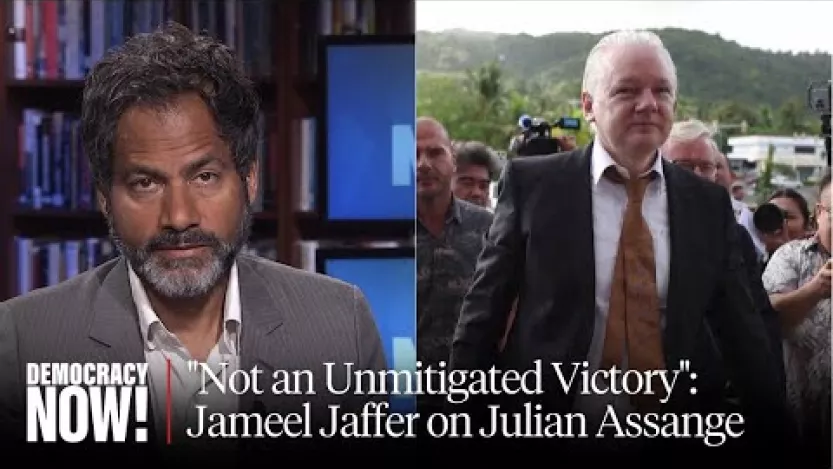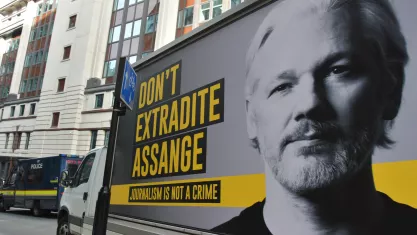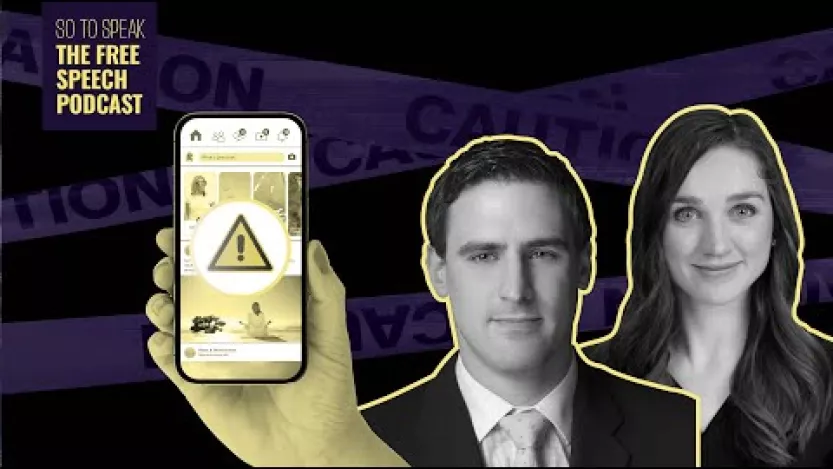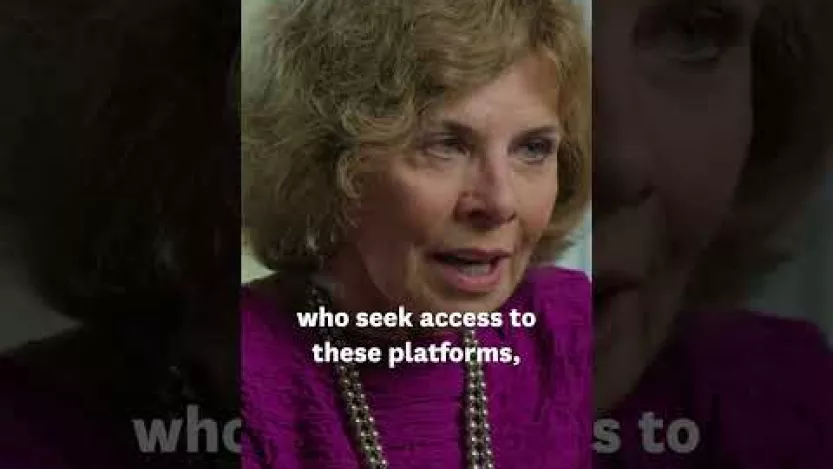Table of Contents
Reflecting on the 2023-24 SCOTUS term: More bust than bang — First Amendment News 430

Fred Schilling / Collection of the Supreme Court of the United States
The Supreme Court as composed June 30, 2022 to present. Clockwise from top left: Amy Coney Barrett, Neil Gorsuch, Brett Kavanaugh, Ketanji Brown Jackson, Elena Kagan, Samuel Alito, Chief Justice John Roberts, Clarence Thomas, and Sonia Sotomayor.
Despite the allure of potential landmark First Amendment expression cases being resolved (e.g., tech platforms cases), the 2023-24 term of the Supreme Court proved more of a bust than a bang. There was only a single First Amendment expression case in which that claim prevailed. Likewise, there was only one in which such a claim lost. The majority of the cases in which a First Amendment expression claim was raised, by sharp contrast, were either left unresolved (one case) or dismissed on non-First Amendment grounds (four cases).
A few notable facts
- In Murthy v Missouri, (another social media case with great potential), Justice Alito argued that “[f]or months, high-ranking Government officials placed unrelenting pressure on Facebook to suppress Americans’ free speech.” Though he would have reached and sustained the First Amendment claim, five of his colleagues agreed with Justice Amy Coney Barrett that there was no Article III standing.
- In Moody v. NetChoice, LLC, Justice Thomas reiterated one of his shocking arguments — namely, that “[f]acial challenges are fundamentally at odds with Article III. Because Article III limits federal courts’ judicial power to cases or controversies, federal courts ‘lac[k] the power to pronounce that [a] statute is unconstitutional’ as applied to nonparties.” Americans for Prosperity Foundation v. Bonta, 594 U. S. 595, 621 (2021) (Thomas, J., concurring in part and concurring in judgment).
- National Rifle Association of America v. Vullo (9-0) was the third majority First Amendment opinion authored by Justice Sonia Sotomayor since she came onto the Court. Both of her previous majority opinions were rendered in cases where the judgment was also 9-0. See Collins and Hudson, “The Roberts Court — Its First Amendment Free Expression Jurisprudence: 2005–2021,” Brooklyn Law Review (2021).
- It is also noteworthy that though Chief Justice John Roberts has, as of 2024, assigned himself the lead opinion in a First Amendment expression case more than any other justice, this term he assigned himself no opinions. (See Collins and Hudson, supra.)
First Amendment expression claims sustained
- National Rifle Association of America v. Vullo (9-0): Per Sotomayor with Gorsuch and Jackson each filing a concurring opinion: The NRA plausibly alleged that former superintendent of the New York Department of Financial Services Maria Vullo violated the First Amendment by coercing regulated entities to terminate their business relationships with the NRA in order to punish or suppress the NRA’s gun-promotion advocacy.
First Amendment expression denied
- Vidal v. Elster (9-0) Justice Clarence Thomas announced the judgment of the court and delivered the opinion of the court, except as to Part III. Justices Samuel Alito and Neil Gorsuch joined that opinion in full; Chief Justice Roberts and Justice Brett Kavanaugh joined all but Part III; and Justice Barrett joined Parts I, II-A, and II-B. Kavanaugh filed an opinion concurring in part, in which Roberts joined. Barrett filed an opinion concurring in part, in which Justice Elena Kagan joined, in which Justice Sotomayor joined as to Part I, II, and III-B, and in which Justice Ketanji Brown Jackson joined as to Parts I and II. Sotomayor filed an opinion concurring in the judgment, in which Kagan and Jackson joined.
First Amendment expression claims not resolved
- Moody v. NetChoice, LLC (9-0): Per Kagan for the majority, which Jackson joined as to Parts I, II and III–A, Barrett filed a concurring opinion, Thomas filed a concurring opinion concurring in the judgment, Alito (joined by Thomas and Gorsuch) filed an opinion concurring in the judgment.
First Amendment Expression claims dismissed on other grounds
- Murthy v Missouri (6-3): Per Barrett with Alito dissenting, joined by Thomas and Gorsuch, decided on Art. III standing grounds.
- Speech First, Inc. v. Sands (6-3): Judgment regarding the bias policy claims vacated, and case remanded to the Court of Appeals for the 4th Circuit with instructions to dismiss those claims as moot. (Jackson dissenting/Thomas and Alito, dissenting.) (See here, re: discussion of lower court opinion.)
- Linkdke v. Freed (9-0): Per Barrett: A public official who prevents someone from commenting on the official’s social-media page engages in state action under 42 U.S.C. § 1983 only if the official both (1) possessed actual authority to speak on the state’s behalf on a particular matter, and (2) purported to exercise that authority when speaking in the relevant social-media posts.
- O’Connor-Ratcliff v. Garnier (per curiam, 9-0) 9th Circuit Court of Appeals’ judgment — that 42 U.S.C. § 1983’s state-action requirement was satisfied because of the “close nexus” between petitioners’ social media pages and their positions as public officials — is vacated, and the case is remanded in light of Lindke v. Freed.
First Amendment expression related case
- Gonzalez v. Trevino (9-0, per curiam): vacated and remanded with Alito, Kavanaugh, and Jackson (joined by Sotomayor) concurring in separate opinions and Thomas dissenting — U.S. Court of Appeals for the 5th Circuit did not properly apply the principles of Nieves v. Barlett.
Scorecard
9-0 Judgments in First Amendment argued cases (Whether or not First Amendment claim was reached or resolved)
- Moody v. NetChoice, LLC (FA claim left unresolved)
- Vidal v. Elster (FA claim denied)
- National Rifle Association of America v. Vullo (FA claim sustained)
- Gonzalez v. Trevino (FA claim sustained)
- Linkdke v. Freed (found state action)
- O’Connor-Ratcliff v. Garnier (state action requirement satisfied)
- Moody v. NetChoice, LLC (FA claim left unresolved)
6-3 Judgments in First Amendment argued cases (Whether or not FA claim was reached or resolved)
- Murthy v Missouri (no Art. III standing)
- Speech First, Inc. v. Sands (dismissed on mootness grounds)
Responses to Assange settlement
- “Assange’s Release “Averted a Press Freedom Catastrophe” But Still Set Bad Precedent: Jameel Jaffer,” Democracy Now! (June 26)
“I do think that it is a great thing for press freedom that we have avoided a judicial ruling from an American court on the scope of the Espionage Act and the scope of First Amendment because from the beginning there has been this real concern among press freedom advocates about the possible implications of this case for journalism.”

- Glenn Thrush and Megan Specia, “A Wish From All Sides to Move On Ends With Liberty for Assange,” The New York Times (June 29)
Some officials appointed under President Biden were never entirely comfortable with the Trump administration’s decision to charge Mr. Assange with activities that skirted the line between espionage and legitimate disclosures made in the public interest, current and former officials said.
- Robert F. Kennedy, Jr., “Treatment of Assange was a shameful stain on our First Amendment,” Fox News (June 27)
- Jordan Howell, “Why Julian Assange couldn’t outrun the Espionage Act,” FIRE (June 26)
- Charles Savage, “A Timeline of Julian Assange’s Legal Saga,” The New York Times (June 24)

Related
- Floyd Abrams, “Why WikiLeaks Is Unlike the Pentagon Papers,” The Wall Street Journal (Dec. 29, 2010)
TikTok’s First Amendment arguments to D.C. Circuit Court
- Lauren Feiner, “TikTok makes its First Amendment case,” The Verge (June 20)
TikTok’s filing has hundreds of pages of communications with the US government, including slide decks and presentations on mitigating national security risks.
TikTok says that the government didn’t adequately consider viable alternative options before charging ahead with a law that could ban the platform in the US. TikTok, whose parent company ByteDance is based in China, claims that it provided the US government with an extensive and detailed plan to mitigate national security risks and that this plan was largely ignored when Congress passed a law with a huge impact on speech.
In briefs filed at the DC Circuit Court on Thursday, both TikTok and a group of creators on the platform who’ve filed their own suit spelled out their case for why they believe the new law violates the First Amendment. The court is set to hear oral arguments in the case on September 16th, just a few months before the current divest-or-ban deadline of January 19th, 2025.
The Protecting Americans from Foreign Adversary Controlled Applications Act would effectively ban TikTok from operating in the US unless it divests from ByteDance by the deadline. The president has the option to extend that deadline slightly if he sees progress toward a deal. But spinning out TikTok is not entirely simple, given the limited pool of possible buyers and the fact that Chinese export law would likely prevent a sale of its coveted recommendation algorithm.
Forthcoming: Tushnet on hate speech
- Mark Tushnet, “Hate Speech,” SSRN (June 26)

Hate speech consists of words of abuse or disparagement about racial and other minorities. Advocates for its regulation contend that hate speech contributes to the silencing of its targets, makes them feel unwelcome in public spaces, and reinforces existing practices of discrimination. Legal regulation of hate speech can alleviate those harms, though its effectiveness might be limited. Enforcement of laws against hate speech can cause collateral damage by deterring some speakers from saying things about public policy affecting minorities that might be mistakenly characterized as hate speech, and by discriminatory enforcement.
The United States is exceptional among the world's liberal democracies in its unwillingness to treat hate speech regulation as consistent with the constitutional protection of expression. The reasons for this exceptionalism include differences among constitutional texts, doctrines dealing with the direct effects of constitutional guarantees of equality on private actors, variation in institutional capacity to guard against abusive enforcement of hate speech laws, and variations in the public trust. This is a draft chapter.
New scholarly article free speech and trademark law
- Jake Linford, “Retrenching Speech Protecting Thresholds in Trademark Law,” SSRN (June 26)
In their 2023 article, “Raising the Threshold for Trademark Infringement to Protect Free Expression,” Christine Haight Farley and Lisa Ramsey argue in favor of a speech-protective fair use test that would replace multiple tests applied by the United States Courts of Appeals when a defendant’s alleged infringement has either informational or expressive elements. This Response explains why this raised threshold test is unlikely to be adopted following the United States Supreme Court’s retrenchment of speech-protective thresholds in Jack Daniel’s Properties, Inc. v. VIP Productions, LLC. That prediction is bolstered by the Court’s likely holding in Vidal v. Elster.
Readers persuaded that current defensive doctrines fail to sufficiently protect expressive and informational trademark uses will find the raised threshold test appealing. However, this Response concludes the proposed test is not constitutionally required. Moreover, applying the raised threshold test will lead courts in a surprisingly broad swath of cases to abandon or severely narrow important elements of current trademark doctrine, some of which are mandated by statute. Those threatened elements help courts correctly calibrate the commercial and expressive interests of trademark owners, alleged infringers, and the trademark-using public.
‘So to Speak’ podcast on warning labels on social media

- “A warning label on social media?” FIRE (June 25)
There is a movement afoot to restrict young people's access to social media and pornography.
Critics of social media and online porn argue that they can be harmful to minors, and states across the country are taking up the cause, considering laws that would impose age-verification, curfews, parental opt-ins, and other restrictions.
Meanwhile, critics of the critics argue that the evidence of harm isn't so conclusive and that many of the proposed restrictions violate core civil liberties such as privacy and free speech.
So, who’s right?
Strossen on ‘the whole scientific method’ and social media censorship
- Nadine Strossen, “The Whole Scientific Method / The Supreme Court & Social Media Censorship,” FIRE (June 2024)

More in the news
- Eugene Volokh, “When May Law Require Social Media Platforms to Disclose Basis for Moderation Decisions?” The Volokh Conspiracy (July 1)
- Stuart Benjamin, “The Supreme Court's Reasoning Prohibits the Deplatforming that the Parties Care About,” The Volokh Conspiracy (July 1)
- “Supreme Court Keeps on Hold Efforts in Texas, Florida To Regulate Social Media Platforms,” First Amendment Watch (July 1)
- Chad Blair, “Legislature 2024 First Amendment Groups Oppose Veto Of Bill To Limit Governor’s Power To Cut Off Electronic Media In Emergencies,” Civil Beat (Honolulu) (July 1)
- Wesley Muller, “Political ‘deepfakes’ remain legal in Louisiana. Gov. Landry has First Amendment concerns,” Louisiana Illuminator (June 30)
- “Racial Justice, Free Speech Groups Join Fight Against Potential TikTok Ban,” First Amendment Watch (June 28)
- “FIRE statement on Murthy v. Missouri,” FIRE (June 26)
2023-2024 SCOTUS term: Free expression and related cases
Cases decided
- O’Connor-Ratcliff v. Garnier
- Speech First, Inc. v. Sands (certiorari granted, judgment, re: the bias policy claims vacated, and case remanded to the Court of Appeals for the 4th Circuit with instructions to dismiss those claims as moot) (Thomas and Alito, dissenting)
- National Rifle Association of America v. Vullo
- Vidal v. Elster
- Gonzalez v. Trevino (vacated and remanded, per curiam with Alito, Kavanaugh, and Jackson (joined by Sotomayor) concurring in separate opinions and Thomas dissenting)
- Murthy v Missouri (decided on Art. III standing grounds)
- Moody v. NetChoice, LLC and NetChoice, LLC v. Paxton
Review granted
- Vidal v. Elster (argued Nov. 1)
- O’Connor-Ratcliff v. Garnier (decided March 15, see below under “State Action”)
- Moody v. NetChoice, LLC and NetChoice, LLC v. Paxton (argued: Feb. 26, 2024)
- National Rifle Association of America v. Vullo (argued March 18, 2024)
- Murthy v Missouri (argued March 18, 2024)
- Gonzalez v. Trevino (argued March 20, 2024)
Pending petitions
- Murphy v. Schmitt
- Villarreal v. Alaniz
- In Re First Choice Women's Resource Centers, Inc.
- Pierre v. Attorney Grievance Commission of Maryland
- No on E, San Franciscans Opposing the Affordable Care Housing Production Act, et al. v. Chiu
- Pierre v. Attorney Grievance Commission of Maryland
- O’Handley v. Weber
State action
- Lindke v. Freed (Barrett, J., 9-0: “The state-action doctrine requires Lindke to show that Freed (1) had actual authority to speak on behalf of the State on a particular matter, and (2) purported to exercise that authority in the relevant posts. To the extent that this test differs from the one applied by the Sixth Circuit, we vacate its judgment and remand the case for further proceedings consistent with this opinion.”)
- O’Connor-Ratcliff v. Garnier (Per curiam: 9-0: “We granted certiorari in this case and in Lindke v. Freed (2024), to resolve a Circuit split about how to identify state action in the context of public officials using social media. Because the approach that the Ninth Circuit applied is different from the one we have elaborated in Lindke, we vacate the judgment below and remand the case to the Ninth Circuit for further proceedings consistent with our opinion in that case.”)
Review denied
- Frank v. Lee
- Mckesson v. Doe (Separate statement by Sotomayor, J.)
- Brokamp v. James
- Griffin v. HM Florida-ORL (application for stay denied)
- M. C. v. Indiana Department of Child Services
- Spectrum et al v. Wendler
- Porter v. Martinez
- Molina v. Book
- Porter v. Board of Trustees of North Carolina State University
- NetChoice, LLC v. Moody
- Alaska v. Alaska State Employees Association
- X Corp. v. Garland
- Tingley v. Ferguson (Justice Kavanaugh would grant the petition for a writ of certiorari. Justice Thomas, dissenting from the denial of certiorari. (separate opinion) Justice Alito, dissenting from the denial of certiorari. (separate opinion)
- Jarrett v. Service Employees International Union Local 503, et al
- Sharpe v. Winterville Police Dept.
- Winterville Police Department v. Sharpe
- Stein v. People for the Ethical Treatment of Animals, Inc., et al.
- Blankenship v. NBCUniversal, LLC
- Center for Medical Progress v. National Abortion Federation
- Frese v. Formella
- Mazo v. Way
Free speech related
- Miller v. United States (pending) (statutory interpretation of 18 U.S.C. § 1512(c) advocacy, lobbying and protest in connection with congressional proceedings.)
- Fischer v. United States (vacated and remanded, 6-3 per Roberts with Barrett, Sotomayor and Kagan dissenting: To prove a violation of §1512(c)(2), the Government must establish that the defendant impaired the availability or integrity for use in an official proceeding of records, documents, objects, or other things used in an official proceeding, or attempted to do so.)
Last scheduled FAN
FAN 429: “What to make of anti-mask laws and mask-required laws?”
This article is part of First Amendment News, an editorially independent publication edited by Ronald K. L. Collins and hosted by FIRE as part of our mission to educate the public about First Amendment issues. The opinions expressed are those of the article’s author(s) and may not reflect the opinions of FIRE or Mr. Collins.
Recent Articles
Get the latest free speech news and analysis from FIRE.

Can the government ban controversial public holiday displays?

The trouble with banning Fizz

FIRE's 2025 impact in court, on campus, and in our culture


